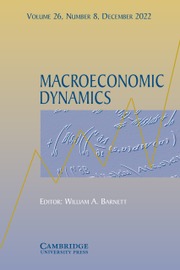Crossref Citations
This article has been cited by the following publications. This list is generated based on data provided by
Crossref.
Harrison, Paul
and
Zhang, Harold H.
1999.
An Investigation of the Risk and Return Relation at Long Horizons.
Review of Economics and Statistics,
Vol. 81,
Issue. 3,
p.
399.
Marshall, David A.
and
Parekh, Nayan G.
1999.
Can Costs of Consumption Adjustment Explain Asset Pricing Puzzles?.
The Journal of Finance,
Vol. 54,
Issue. 2,
p.
623.
Constantinides, George M.
Donaldson, John B.
and
Mehra, Rajnish
2000.
Junior Can't Borrow: A New Perspective on the Equity Premium Puzzle.
SSRN Electronic Journal ,
Brav, Alon
Constantinides, George M.
and
Geczy, Christopher Charles
2000.
Asset Pricing with Heterogeneous Consumers and Limited Participation: Empirical Evidence.
SSRN Electronic Journal ,
Balduzzi, Pierluigi
and
Yao, Tong
2001.
Does Heterogenity Matter for Asset Pricing?.
SSRN Electronic Journal ,
Cogley, Timothy
2002.
Idiosyncratic risk and the equity premium: evidence from the consumer expenditure survey.
Journal of Monetary Economics,
Vol. 49,
Issue. 2,
p.
309.
Fiszeder, Piotr
and
Romański, Jerzy
2002.
East European Transition and EU Enlargement.
p.
355.
Cohen, Randolph B.
Polk, Christopher K.
and
Vuolteenaho, Tuomo
2002.
Does Risk or Mispricing Explain the Cross-Section of Stock Prices.
SSRN Electronic Journal,
Vissing‐Jørgensen, Annette
2002.
Limited Asset Market Participation and the Elasticity of Intertemporal Substitution.
Journal of Political Economy,
Vol. 110,
Issue. 4,
p.
825.
Constantinides, George M.
2002.
Rational Asset Prices.
The Journal of Finance,
Vol. 57,
Issue. 4,
p.
1567.
Gabaix, Xavier
and
Laibson, David I.
2002.
The 6D Bias and the Equity Premium Puzzle.
SSRN Electronic Journal ,
Menzly, Lior
Santos, Jesus Tano
and
Veronesi, Pietro
2002.
The Time Series of the Cross Section of Asset Prices.
SSRN Electronic Journal,
Buraschi, Andrea
and
Jiltsov, Alexei
2003.
Term Structures of Interest Rates and Inflation in Economies with Habit Formation.
SSRN Electronic Journal ,
Mehra, Rajnish
and
Prescott, Edward C.
2003.
Financial Markets and Asset Pricing.
Vol. 1,
Issue. ,
p.
889.
Cohen, Randolph B.
Polk, Christopher
and
Vuolteenaho, Tuomo
2003.
The Price Is (Almost) Right.
SSRN Electronic Journal,
Julliard, Christian
and
Parker, Jonathan A.
2004.
Consumption Risk and the Cross-Section of Expected Returns.
SSRN Electronic Journal,
Menzly, Lior
Santos, Tano
and
Veronesi, Pietro
2004.
Understanding Predictability.
Journal of Political Economy,
Vol. 112,
Issue. 1,
p.
1.
Wang, Yong
and
Jagannathan, Ravi
2005.
Lazy Investors, Discretionary Consumption, and the Cross Section of Stock Returns.
SSRN Electronic Journal,
Parker, Jonathan A.
and
Julliard, Christian
2005.
Consumption Risk and the Cross Section of Expected Returns.
Journal of Political Economy,
Vol. 113,
Issue. 1,
p.
185.
BANSAL, RAVI
DITTMAR, ROBERT F.
and
LUNDBLAD, CHRISTIAN T.
2005.
Consumption, Dividends, and the Cross Section of Equity Returns.
The Journal of Finance,
Vol. 60,
Issue. 4,
p.
1639.

